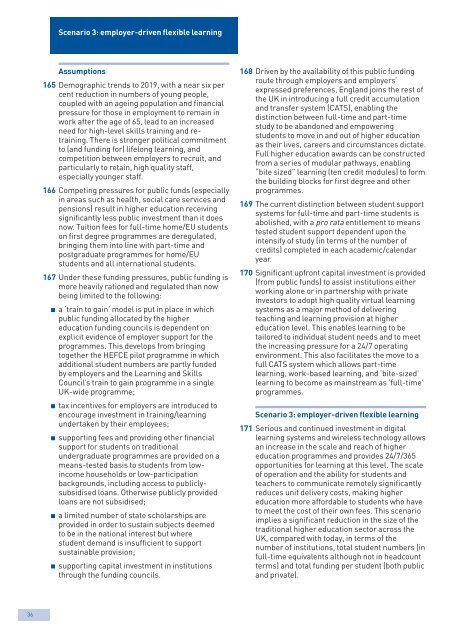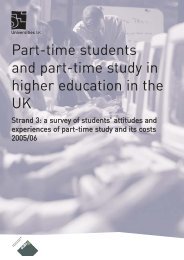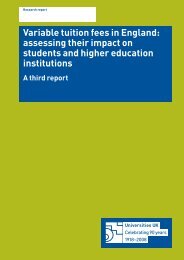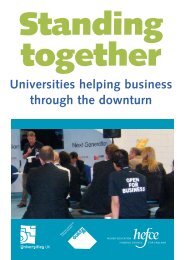The future size and shape of HE - Universities UK
The future size and shape of HE - Universities UK
The future size and shape of HE - Universities UK
- No tags were found...
Create successful ePaper yourself
Turn your PDF publications into a flip-book with our unique Google optimized e-Paper software.
Scenario 3: employer-driven flexible learningAssumptions165 Demographic trends to 2019, with a near six percent reduction in numbers <strong>of</strong> young people,coupled with an ageing population <strong>and</strong> financialpressure for those in employment to remain inwork after the age <strong>of</strong> 65, lead to an increasedneed for high-level skills training <strong>and</strong> retraining.<strong>The</strong>re is stronger political commitmentto (<strong>and</strong> funding for) lifelong learning, <strong>and</strong>competition between employers to recruit, <strong>and</strong>particularly to retain, high quality staff,especially younger staff.166 Competing pressures for public funds (especiallyin areas such as health, social care services <strong>and</strong>pensions) result in higher education receivingsignificantly less public investment than it doesnow. Tuition fees for full-time home/EU studentson first degree programmes are deregulated,bringing them into line with part-time <strong>and</strong>postgraduate programmes for home/EUstudents <strong>and</strong> all international students.167 Under these funding pressures, public funding ismore heavily rationed <strong>and</strong> regulated than nowbeing limited to the following:p a ‘train to gain’ model is put in place in whichpublic funding allocated by the highereducation funding councils is dependent onexplicit evidence <strong>of</strong> employer support for theprogrammes. This develops from bringingtogether the <strong>HE</strong>FCE pilot programme in whichadditional student numbers are partly fundedby employers <strong>and</strong> the Learning <strong>and</strong> SkillsCouncil’s train to gain programme in a single<strong>UK</strong>-wide programme;p tax incentives for employers are introduced toencourage investment in training/learningundertaken by their employees;p supporting fees <strong>and</strong> providing other financialsupport for students on traditionalundergraduate programmes are provided on ameans-tested basis to students from lowincomehouseholds or low-participationbackgrounds, including access to publiclysubsidisedloans. Otherwise publicly providedloans are not subsidised;p a limited number <strong>of</strong> state scholarships areprovided in order to sustain subjects deemedto be in the national interest but wherestudent dem<strong>and</strong> is insufficient to supportsustainable provision;p supporting capital investment in institutionsthrough the funding councils.168 Driven by the availability <strong>of</strong> this public fundingroute through employers <strong>and</strong> employers’expressed preferences, Engl<strong>and</strong> joins the rest <strong>of</strong>the <strong>UK</strong> in introducing a full credit accumulation<strong>and</strong> transfer system (CATS), enabling thedistinction between full-time <strong>and</strong> part-timestudy to be ab<strong>and</strong>oned <strong>and</strong> empoweringstudents to move in <strong>and</strong> out <strong>of</strong> higher educationas their lives, careers <strong>and</strong> circumstances dictate.Full higher education awards can be constructedfrom a series <strong>of</strong> modular pathways, enabling“bite <strong>size</strong>d” learning (ten credit modules) to formthe building blocks for first degree <strong>and</strong> otherprogrammes.169 <strong>The</strong> current distinction between student supportsystems for full-time <strong>and</strong> part-time students isabolished, with a pro rata entitlement to meanstested student support dependent upon theintensity <strong>of</strong> study (in terms <strong>of</strong> the number <strong>of</strong>credits) completed in each academic/calendaryear.170 Significant upfront capital investment is provided(from public funds) to assist institutions eitherworking alone or in partnership with privateinvestors to adopt high quality virtual learningsystems as a major method <strong>of</strong> deliveringteaching <strong>and</strong> learning provision at highereducation level. This enables learning to betailored to individual student needs <strong>and</strong> to meetthe increasing pressure for a 24/7 operatingenvironment. This also facilitates the move to afull CATS system which allows part-timelearning, work-based learning, <strong>and</strong> ’bite-<strong>size</strong>d’learning to become as mainstream as ’full-time’programmes.Scenario 3: employer-driven flexible learning171 Serious <strong>and</strong> continued investment in digitallearning systems <strong>and</strong> wireless technology allowsan increase in the scale <strong>and</strong> reach <strong>of</strong> highereducation programmes <strong>and</strong> provides 24/7/365opportunities for learning at this level. <strong>The</strong> scale<strong>of</strong> operation <strong>and</strong> the ability for students <strong>and</strong>teachers to communicate remotely significantlyreduces unit delivery costs, making highereducation more affordable to students who haveto meet the cost <strong>of</strong> their own fees. This scenarioimplies a significant reduction in the <strong>size</strong> <strong>of</strong> thetraditional higher education sector across the<strong>UK</strong>, compared with today, in terms <strong>of</strong> thenumber <strong>of</strong> institutions, total student numbers (infull-time equivalents although not in headcountterms) <strong>and</strong> total funding per student (both public<strong>and</strong> private).36
















